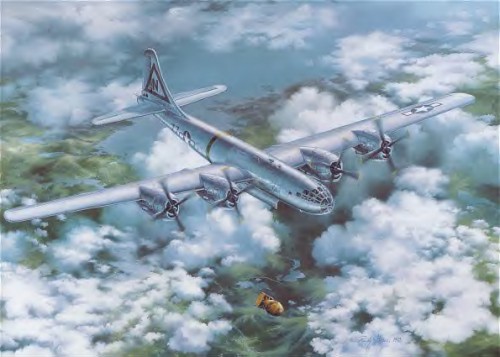

At first, the B-29's flew there first mission against Japan from China.But, in 1944, the Imperial Japanese Army was once again gaining ground in China, so the Bomber force was moved to the Marianas.From that point on, the air war crecentoed.20 Bomber Groups, with formation of up to 500 planes, use high-alitude pressision daylight bombing against Japan.This, however, was largely ineffective, as for the weather.So, General Curtiss LeMay, Commander of the XXI Bomber Command of the Twentieth Air Force, insisted to Washington, D.C. that they should switch to low-level nighttime fire bombing.Generally because most Japanese buildings were wooden an crowded together.He purposed mixing the bombs with High-Expolsive Anti-Personnel Bombs and Incendiary Bombs.Reason for this was because the Anti-Personnel Bombs would keep the firefighters away from the fires long enough for them to get out of control.
When the fire bombing campaign was underway, he didn't just bomb industry target but the cities themselves.He systematically set fire to Japanese cities starting with Tokyo on the night of March 9-10, 1945.By mid-June, 250 square miles were laid burnt and wasted, scattered among six major cities in Japan.Over 83,000 were killed in these raids.More people died during this campaign than in the Japanese Army through-out the war.By wars end, over 200,000 had died.But, it wasn't over yet.
After the bloodbath of Okinawa, American war planners had their eyes set on the Japanese home islands.Since the incredible loss of life at both Iwo Jima and Okinawa, and the damage to the Navy during each invasion, the next move looked bleek.If the Allies were to invaded Japan, the loss of life would be enormous.At least one million people would die on each side and the Japanese people would probably cease to exsist.So, as they looked for a solution to this problem, on a steel tower in New Mexico, a new weapon was tested.The Atomic Bomb.This bomb had the capability to destroy an entire city in one blast.So, as the war raged, President Harry Truman faced a lonely decision, invaded and lose a million people, or nuke them and kill 100,000 in an instant.He made his mind up.
He issued a ultimatum to the Japanese government and people; "Surrender or face utter destruction." No word was heard from Tokyo.So, President Truman ordered the attack.On August 6, 1945, the Enola Gay, flown by Col. Paul Tibbets, Jr., flew toward Hiroshima.It was a hot day there.In the mid-morning, a blinding flash was seen, and, in a instant, 60,000 people were vaporized.Another 40,000 died from radiation.Still, no word from Tokyo.At this time, the Imperial Cabinet was split over war and peace.With not a word heard, this lead to Allied reaffirming belief that the Japanese were going to fight to the death.So, the decision was made to drop the second atomic bomb, this time on Kokura on August 9.But bad weather forced "Bock's Car" to drop it on Nagasaki, which killed 40,000 the same way as Hiroshima.The Emperor, horrified at the unbelievible destrustion, broke tradition.Instead of being a "figure head" of Japanese government, he urged the Cabinet to sue for peace.Since Emperor Hirohito was a living god to the Japanese people, they had no choice.But, still it took the Japanese 5 days to reply.On August 14th, the Allies lauched a 1000 plane raid on Toyko, Nagoya, and other Japanese cities.On their way back, the war was over.
So, as we have seen in the European theatre, Air Power proved, that if it worked with other branches of service, that together, they could win.Air Power paved the way for the Invasion Fleets and for the galant G.I.'s and Marines to defeat and eventually, destroy the Japanese.
Home